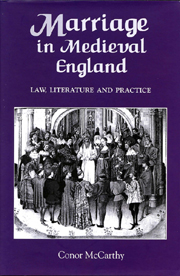6 - Marriage and Family
Published online by Cambridge University Press: 12 September 2012
Summary
Family and kinship
Familia, as David Herlihy tells us, comes from the noun famulus, ‘a slave,’ and the original meaning of familia was a band of slaves, a meaning that persisted after the decline of slavery to refer to groups of servants or serfs. This meaning of familia extended to include all persons placed under the authority of a single person, an authority that could include the patria potestas of a man over his wives and children. Hence its modern sense.
It is generally agreed that the medieval family was a nuclear family, essentially based around a core unit of a coresidential couple and its offspring, although it might also include other family members for periods of time, and the household, as opposed to the family, might also include other persons such as domestic servants (or slaves in the early Middle Ages), agricultural labourers, or children from outside the immediate family who were being fostered. Herlihy argues that the rise of the nuclear family comes about with the decline in Europe of large scale farm management by bands of slaves, and the rise in its place of peasant farming, which created farms that could support a small family unit.
In the early Middle Ages, however, it is usually thought that the extended kin group played an important social role, particularly in regard to seeing that obligations by and to other members of kin were kept, and in the obligation to avenge family members killed as a result of feud.
- Type
- Chapter
- Information
- Marriage in Medieval EnglandLaw, Literature and Practice, pp. 126 - 138Publisher: Boydell & BrewerPrint publication year: 2004



